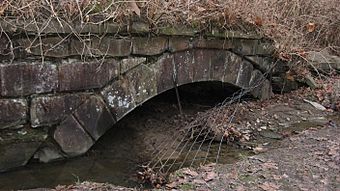Cincinnati and Whitewater Canal Tunnel facts for kids
Quick facts for kids |
|
|
Cincinnati and Whitewater Canal Tunnel
|
|

Closeup of the tunnel's northern end
|
|
| Location | Parallel to Miami Avenue at the Wamsley Avenue junction, Cleves, Ohio |
|---|---|
| Area | 1.3 acres (0.53 ha) |
| Built | 1837 |
| Architect | Darius Lapham; S. and H. Howard and Company |
| Architectural style | Brick lined canal tunnel |
| NRHP reference No. | 01000562 |
| Added to NRHP | May 25, 2001 |
The Cincinnati and Whitewater Canal Tunnel is an old, abandoned tunnel in Ohio, near the town of Cleves. It was built a long time ago, in 1837, as part of a canal system called the Whitewater Canal. Even though it's not used anymore, it's an important historic site because it was the first tunnel of its kind in Ohio.
Building the Whitewater Canal Tunnel
After the state of Indiana started building the Whitewater Canal in the 1830s, business leaders in Ohio wanted to extend it. They wanted the canal to reach the city of Cincinnati. This new part was called the Cincinnati and Whitewater Canal.
The entire canal was finished in 1843. However, the tunnel near the village of North Bend was completed much earlier, in 1837. This tunnel was necessary because a steep hill separated North Bend from Cleves.
The land for the tunnel belonged to William Henry Harrison. He was a famous war hero who later became president. Harrison supported the canal and was happy to sell his land for the tunnel. He also provided wood and bricks for its construction.
How the Tunnel Was Built
The tunnel was lined with bricks. Its entrances, called portals, were made of carefully cut stone blocks. These entrances also had "wing walls" that spread out like wings.
When it was finished, the tunnel was about 0.3 miles (0.5 kilometers) long. The distance from the ceiling to the bottom of the canal was 22 feet (6.7 meters).
Usually, canal tunnels needed people called "leggers" to push boats through. This was because there wasn't enough room for horses or mules to walk beside the boat. But this tunnel was special. It had a path, called a towpath, inside for animals. Even so, most boats still used human power to get through. The animals would walk over the hill instead.
This tunnel was the first of its kind in Ohio. It had some problems during its history. During construction, part of the tunnel collapsed, and six workers sadly lost their lives. Another part of the tunnel caved in during the 1950s. This happened when workers were improving a road, U.S. Route 50, that goes over the tunnel.
What Happened to the Tunnel?
Despite all the effort to build the Whitewater Canal, it was abandoned in 1856. Many floods had damaged large parts of it. This meant the canal tunnel was also no longer used.
For a while, the tunnel was empty. But in 1863, a railroad company started using it. For 25 years, it served as a regular train tunnel. The train line stopped using it in 1888.
Since then, the tunnel has become completely unusable. It has filled up with dirt and mud, almost to the ceiling. However, people haven't completely forgotten about it. In 2000, the Ohio History Connection and other groups placed a historical marker near the tunnel's northern entrance.
In 2001, the tunnel was added to the National Register of Historic Places. This is a list of important historical sites in the United States. The tunnel is important because very few canal tunnels were ever built in the U.S.



